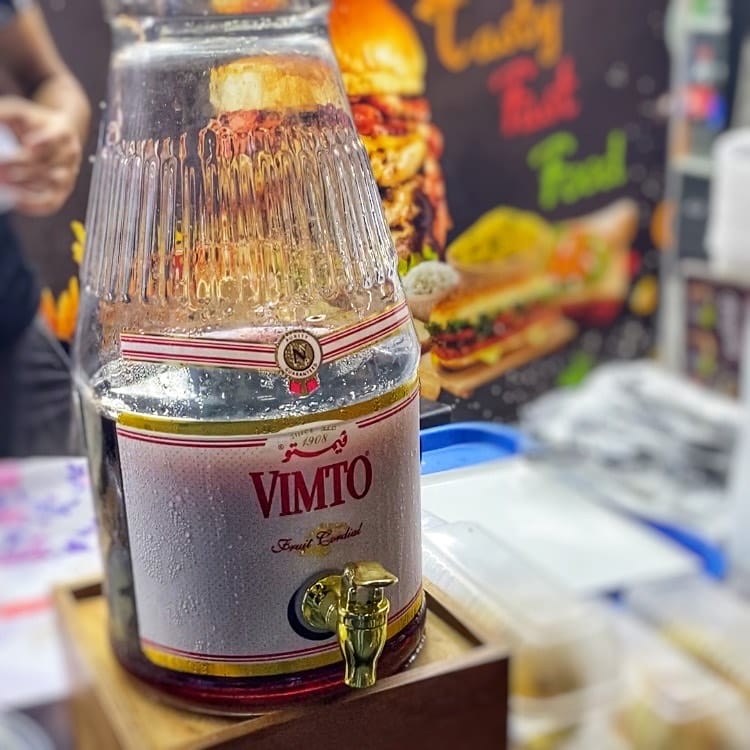During the holy month of Ramadan, many Muslims around the world enjoy a sweet and fruity drink called Vimto. In fact we enjoy it on our Dubai Souks Iftar tour that takes place at Iftar time during Ramadan! But why is this particular beverage so popular during this time? In this article, we’ll delve into the history and cultural significance of Vimto in Ramadan.
The origins of Vimto and its early popularity in the UK.
Vimto was first created in 1908 by John Noel Nichols, a British man who manufactured soft drinks. The original recipe included a blend of grape, raspberry, and blackcurrant juices, along with a secret mix of herbs and spices. According to the Vimto website, it began as a herbal tonic called ‘Vimtonic’ that would give people ‘vim and vigour’ and Nichols distributed the drink to “small outlets, cafes and temperance bars.”
The drink quickly gained popularity in the UK, particularly among children, and became a staple in British households. The first international market was India in 1924, where the drink became a hit with both nostalgic British troops and Indian locals. However, it wasn’t until much later that Vimto became associated with Ramadan.
The role of Vimto in Middle Eastern culture and its association with Ramadan.
Vimto’s popularity during Ramadan can be traced back to 1927, when it was first introduced to the region by the Saudi headquartered Aujan family. The sweet and fruity taste of the drink quickly caught on, and it became a popular choice for breaking the fast during Ramadan. Over time, Vimto became more than just a drink – it became a symbol of the holy month and a cultural phenomenon. Today, it is a staple in many Middle Eastern households during Ramadan, and its popularity shows no signs of slowing down. In fact, the regional experience with this drink is so enduring that Vimto started to stock their product in select stores in North America for Middle Eastern and African immigrants.
The marketing strategies that helped Vimto become the official drink of Ramadan.
Vimto’s success during Ramadan can be attributed to a number of marketing strategies. One of the key factors was the brand’s ability to tap into the cultural significance of the holy month. By positioning itself as a drink that was perfect for breaking the fast, Vimto was able to establish a strong emotional connection with consumers. The brand also invested heavily in advertising and sponsorship, partnering with local events and influencers to promote its products.
Additionally, Vimto adapted its product offerings to cater to local tastes, introducing new flavors and packaging options that resonated with Middle Eastern consumers. For example, during the Ramadan of 2015, you could visit Dubai Mall to get a personalized Vimto bottle with your name on it—even encrusted with Swarovski crystals if you wished!
All of these factors combined to make Vimto the official drink of Ramadan, and a beloved part of the holiday for millions of people around the world.
The cultural significance of Vimto during Ramadan and its impact on communities.
Vimto’s popularity during Ramadan goes beyond just being a refreshing drink to break the fast. For many communities, it has become a symbol of togetherness and tradition. Sharing a glass of Vimto with family and friends after a long day of fasting has become a cherished ritual, and the drink has become a staple at iftar gatherings.
Overall, Vimto’s success during Ramadan is a testament to the power of marketing that is rooted in cultural understanding and emotional connections. It’s safe to say that Vimto will remain a beloved part of Ramadan traditions for years to come.

Arva Ahmed is the co-founder of Frying Pan Adventures, Dubai’s first food tour company, and a celebrated food explorer known for uncovering Dubai’s hidden culinary gems. Her expertise in the city’s diverse food scene has been featured in prominent publications such as CNN, Khaleej Times, BBC Travel, The Sun, The Independent and countless more. She also hosts Ditch the Silver on YouTube. Through her immersive tours and storytelling, Arva brings Dubai’s rich flavors and vibrant cultures to life.




